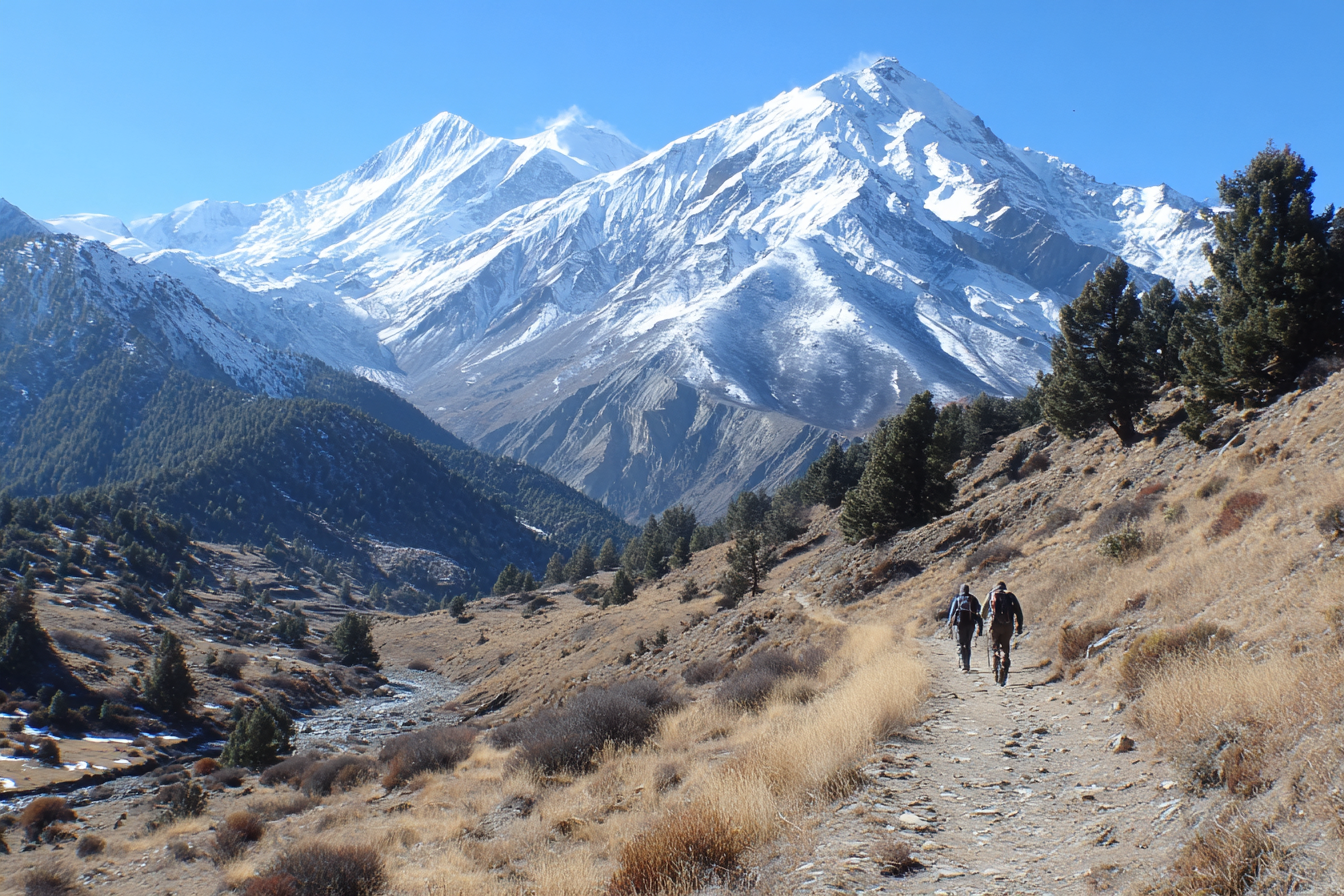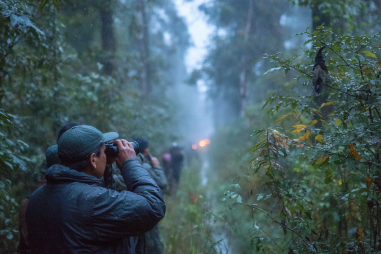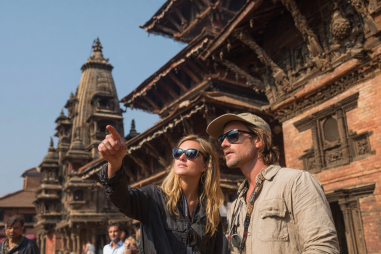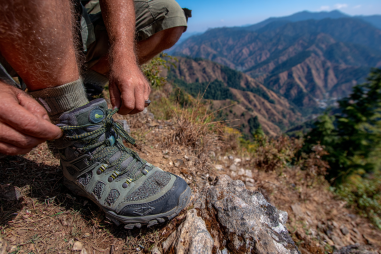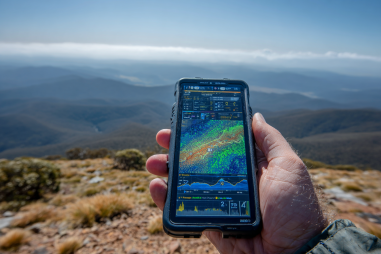Nestled in the heart of the Annapurna region in Nepal, Jomsom trekking is a captivating journey that blends stunning natural beauty with rich cultural experiences. As one of the most accessible treks in the Himalayas, it offers adventurers breathtaking views of towering peaks, deep gorges carved by the Kali Gandaki River, and vibrant Thakali culture. Whether you’re an experienced trekker or a first-timer, this ultimate Jomsom trekking guide will equip you with everything you need to know—from popular routes and the best seasons to practical tips on gear, accommodation, and local customs. Get ready to embark on an unforgettable adventure through one of Nepal’s most scenic and culturally diverse regions.
Overview of Jomsom Trekking
The Jomsom trek primarily follows the Kali Gandaki Gorge, which is considered one of the deepest gorges in the world. This trek takes you from the lower mid-hill regions through arid landscapes to alpine meadows, with spectacular panoramas of Annapurna, Dhaulagiri, and Nilgiri peaks. The area is home to the Thakali people, known for their unique language and traditions. Trekking in Jomsom offers a variety of experiences—from visiting ancient monasteries to exploring bustling mountain bazaars.
This trek is often chosen for its accessibility; the trek usually starts from Jomsom, which is reachable by a short flight or jeep ride from Pokhara. The trail connects several picturesque villages, including Kagbeni, Muktinath, and Marpha, before ending in Tatopani or reaching further into the Annapurna circuit. Jomsom trekking is suitable for moderate-level trekkers as it involves manageable altitudes and well-established paths.
Key Routes and Trail Options
There are several popular trail options when trekking in the Jomsom region. Here are some of the most common routes:
- Jomsom to Muktinath Trail: This is the most well-known route, a 5-7 day trek starting at Jomsom and heading north to Muktinath, an important pilgrimage site. Along the way, trekkers pass stunning landscapes, quaint villages like Kagbeni, and the iconic Kali Gandaki Gorge.
- Marpha to Jomsom Loop: A shorter route that allows trekkers to experience the cultural hub of Marpha, famous for its apple orchards and traditional mustard oil production, before returning to Jomsom.
- Jomsom to Tatopani Trek: This route takes trekkers south from Jomsom towards Tatopani, where natural hot springs offer a perfect place to relax after several days of trekking.
- Annapurna Circuit Extension: For those seeking a longer adventure, Jomsom serves as an entry point to the larger Annapurna Circuit, with options to extend the trek towards Manang and beyond.
Whichever route you choose, be prepared for varied terrain, including dusty trails, rocky paths, and some steep ascents. The trails are well-marked, making navigation relatively easy.
Best Times to Trek in Jomsom
Timing your Jomsom trekking adventure is crucial to enjoying pleasant weather and clear views. The best seasons to visit are:
- Spring (March to May): This is one of the most popular trekking seasons. The weather is warm and stable, rhododendrons bloom beautifully along the trails, and the skies are generally clear, providing excellent mountain views.
- Autumn (September to November): Another ideal trekking season with mild temperatures and minimal rainfall. The air is crisp and clean, perfect for photography and sightseeing.
- Winter (December to February): While colder, particularly at higher altitudes, winter trekking in Jomsom can still be rewarding with fewer crowds and snow-capped mountain vistas. Keep in mind some days may be chilly, especially in the mornings and evenings.
- Monsoon Season (June to August): Not recommended due to heavy rains, slippery trails, and frequent landslides. However, Jomsom tends to receive less rainfall than other regions in Nepal because of its rain-shadow location, but caution is still advised.
What to Pack for Jomsom Trek
Packing smartly for the Jomsom trek will make your journey much more comfortable. Here’s a list of essentials:
- Sturdy trekking boots with good ankle support
- Layered clothing – moisture-wicking base layers, insulating mid-layers, and a waterproof outer shell
- Warm hat, gloves, and thermal wear for colder evenings
- Sunglasses with UV protection and sunscreen
- A good quality daypack with rain cover
- Reusable water bottle and water purification tablets or filter
- Personal first aid kit including any prescription medications
- Trekking poles to assist on uneven terrain
- Headlamp or flashlight
- Camera or smartphone for capturing unforgettable moments
- Snacks like energy bars, nuts, and dried fruits
- Cash in small denominations for villages with limited ATM access
Additionally, keep your luggage weight manageable if you plan to hire porters or guides.
Accommodation Options Along the Route
Trekking in Jomsom offers a range of accommodation choices, mostly consisting of teahouses and guesthouses that provide clean, simple rooms and meals. These lodges are located in villages along the trail and typically include:
- Basic twin or shared rooms with beds and blankets
- Shared or private bathrooms (sometimes with hot showers, depending on the lodge)
- Dining areas serving local and occasional Western cuisine
In popular spots like Jomsom, Kagbeni, and Muktinath, you can find a wider range of services, including Wi-Fi and battery charging. Castle or luxury accommodations are limited, so be prepared for rustic conditions, especially in more remote villages. Booking ahead is not usually necessary in peak season but can be helpful for larger groups.
Cultural Highlights and Local Communities
Jomsom trekking affords an immersive cultural experience. The trail passes through traditional villages inhabited mostly by the Thakali people, known for their warm hospitality and unique lifestyle. As you traverse these communities, you’ll get the chance to:
- Visit ancient gompas (Buddhist monasteries), such as the Annapurna Gompa in Kagbeni
- Explore the sacred Muktinath Temple, revered by both Hindus and Buddhists
- Sample Thakali cuisine, including varieties of dal bhat, momo dumplings, and local apple products like cider and brandy
- Observe traditional crafts such as weaving and mustard oil extraction in Marpha village
- Interact with friendly villagers and learn about their festivals and way of life
The fusion of Tibetan and Nepalese culture in Jomsom adds a fascinating dimension to the trekking experience.
Safety and Health Tips
Staying safe and healthy while trekking in Jomsom is essential to enjoying your adventure:
- Acclimatize properly: Although the altitudes are moderate compared to higher Himalayan treks, altitude sickness can still affect some trekkers. Spend a day or two acclimatizing in Jomsom or nearby villages.
- Stay hydrated: Drink plenty of water and avoid alcohol during the trek.
- Use sunscreen and sunglasses: The sun can be intense, especially at high altitudes.
- Watch your footing: Trails can be uneven and rocky; sturdy footwear and trekking poles help reduce injury risks.
- Follow local advice and weather updates: Sudden weather changes can occur, so stay informed through guides or local news.
- Carry basic medical supplies: Including blister treatments, pain relievers, and altitude sickness medication if prescribed by your doctor.
- Respect wildlife and local customs: Minimizing environmental impact and being culturally sensitive fosters a safer environment for everyone.
How to Hire Guides and Porters
Hiring a guide or porter in Jomsom is highly recommended, especially if it’s your first trek or you’re unfamiliar with the local environment. Guides offer valuable insights into the culture, geography, and help navigate the trails safely. Porters can carry heavy bags, allowing you to enjoy the trek more comfortably.
There are reputable trekking agencies in Pokhara and Kathmandu that arrange guides and porters for Jomsom treks. When hiring, consider the following:
- Choose licensed guides and porters affiliated with local trekking associations for safety and professionalism.
- Discuss the scope of services, fees, and tips upfront to avoid misunderstandings.
- Ensure porters are properly equipped and paid fairly; support ethical employment practices.
- Consider hiring a guide knowledgeable in local culture and language, enhancing the overall experience.
Many trekkers opt for package tours, but independent trekkers can also arrange guides and porters along the route or in advance.
Getting Ready for Your Trekking Adventure
With its stunning landscapes, rich culture, and welcoming communities, Jomsom trekking is a remarkable introduction to Nepal’s Himalayan wonders. By understanding the routes, packing the right gear, and respecting the local environment and traditions, you’ll set yourself up for a safe, enjoyable, and memorable journey.
Take time to plan your trip around the ideal season, prepare physically, and consider hiring knowledgeable guides to enhance your experience. Whether you explore the pilgrimage sites, savor local flavors, or simply soak in the vast mountain panoramas, the Jomsom trek offers an adventure that stays with you long after the trail ends. Lace up your boots and get ready to discover the magic of this breathtaking region.

